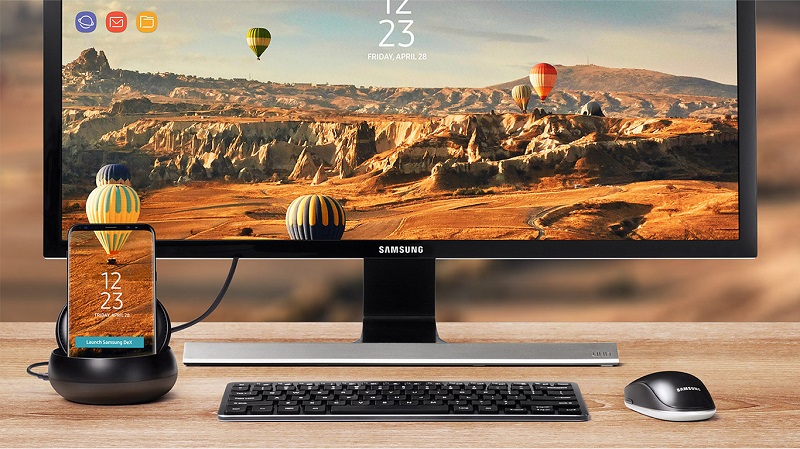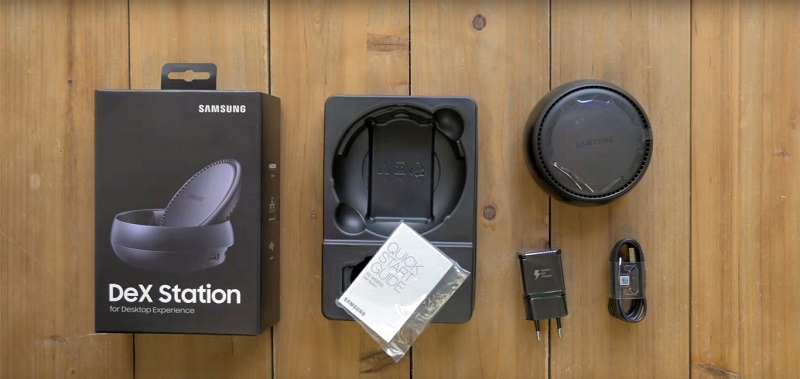Oh, the promise of convergence between mobile and desktop! We have been listening to it for many years and there have been projects for brands such as Motorola (Atrix), HP (Elite X3) or Microsoft and its Continuum, although none have yet to consolidate. That is why, when Samsung announced its DeX as one of the main novelties with the launch of the S8, we are full of skepticism and, above all, wanting to try it on a daily basis beyond a first impressions.
Samsung DeX to work and this has been my experience …
Samsung DeX costs 159 dollars and in the box comes the own workstation, the power adapter (USB-C) and the instruction manual. In order to test Samsung’s mobile-to-desktop experience, you’ll also need a Galaxy S8 or S8 + (for now the only two compatible devices), a display / monitor with HDMI, a mouse, a keyboard, and optionally an Ethernet cable for not having to surf from the Wi-Fi on your phone.
Getting it started is quite simple. Just connect everything to the DeX in their respective port and, finally, put our S8 in the station. At that time, you will see on the phone screen a prompt to switch to DeX mode or to mirroring. We give it to DeX mode and, after a brief tutorial, we will be using our mobile as a computer.

The process is fast, fluid and we do not detect any type of latency when starting or passing from one mode to another. As technical notes: the DeXport HDMI port is only capable of up to 4K and 30 fps, the Ethernet will allow connections up to 100 mbps and the two USBs to connect mouse and keyboard are 2.0.
The base also includes a fan to cool our smartphone if necessary, especially when we perform heavy tasks in different applications. And, of course, when our S8 is connected to the base, it will be charging (in fact, as the output is USB-C, this is one of the reasons why it does not support S7 or S7 edge).
Okay, we have everything ready and working, and what do I use it for now? On the screen we see the DeX interface, an Android adaptation that we will have to handle with keyboard and mouse.
Below the left is the application drawer (which are, logically, the ones we have installed in our S8 or S8 +). This is where the trick comes: not all applications are optimized for DeX. In this section, Samsung has created a tab in which are all compatible apps and in total, for now, there are 19 available, a very small number, although there are some fundamental to work as Word, PowerPoint, Drive, Gmail or Adobe Lightroom.
What does it mean that they are not optimized? In the best case, we can not put them to full screen or take longer to load. At worst, they do not directly work, as with some games (which can only be played with touchscreen).
Just to the right we have a button to open the recent applications (comparable to the multitasking button of our smartphone) and a ‘Home’ button to return to the home screen. To the right side of these we will be able to fix applications to the navigation bar like we do in PC, something very useful to not have to go looking for the application in question every time that we want to execute it.

The system notifications appear in the bottom right of the screen and their appearance is very similar to the one we see in the S8. Here we can also check the battery, time, coverage, WiFi, sound profiles, etc.
Can you use the phone while it is in the dock? Yes, we can make and receive calls and text messages and use push applications like WhatsApp, Telegram or Hangouts. In the latter case, when there is a video call involved, because of the position of the phone in the workstation, your face will appear in a strange frame and you probably have to approach the camera to see you better.
And where are the calls heard? From the loudspeakers of our telephone. If we have bluetooth speakers on hand, it can be a good solution to finish completing the desktop experience and, for example, be able to listen to music more comfortably (and with better quality).
You may also like to read: All you need to know about USB cables with Type C connector
Pros and Cons
Aside from how easy it is to launch the DeX mode, what caught my attention the whole process is the little friction there is. I explain. When you run an application like Word, you do not notice any difference between the experience you have on a PC and DeX. In fact, if they hid the computer and told me to write or edit a document, I would not know if I’m using a PC or an S8 via DeX. This with optimized applications, of course, with the rest the experience is far from being something like convergence.
I have been able to create and save documents, presentations .ppt, send mails, edit images in Lightroom, put YouTube videos, use WhatsApp / Telegram, receive calls and play (few) games. And at all times the experience is to be using a PC. No delays, no application crashes.

The problem comes with DeX’s own limitations right now. Less than 20 optimized applications is a very small number for an ecosystem like Android. And, yes, we have the option to use virtual and remote desktops via VDI solutions such as Citrix Receiver, VMware Horizon or Amazon WorkSpaces, which will allow us to work in a Windows environment, but if it is a clear and simple convergence, ecosystem of applications has to be larger.
And here we understand that the developers will push the project as long as there is a user base that supports DeX. It is understandable that on a scale of priorities work for the most used and sold products, so possibly these first steps of DeX are slower than desirable.
What about games? Well, for now there are very few optimized. One of them is ‘The Tribez’, a very basic game of management in which we have to build a city. We were able to put it on the big screen and it is quite entertaining, but, of course, it is still a very simple title.
Of the games that are not optimized, many do not work. Pressing the mouse or keyboard simply does nothing. Other titles not optimized for DeX, such as the hit ‘Clash Royale’, work well but you will not be able to change the screen size and, depending on your monitor, it may look too small.
Last but not least, many may wonder if the phone gets too hot in DeX mode. The truth is that in PC environments we are accustomed to run many things at once and here the S8 responds very well (the 4GB of RAM are still giving), but it is true that when we take a while the phone warms up more normal. It’s nothing dramatic, but it’s a good idea that Samsung has included a fan in the station to cool our phone. Here is to remember that while connected to the base the S8 is being charged, a process in which the mobile also heats up more.
In short: Samsung DeX outlines a very good road for convergence between mobile and PC. It presents a fluid system, simple, intuitive and with which we can really work without problems in office environments, mail, web and light edition of images and videos.
Like all the beginnings, it has challenges ahead, but if someone has lung for a background race like this, surely a giant like Samsung.
